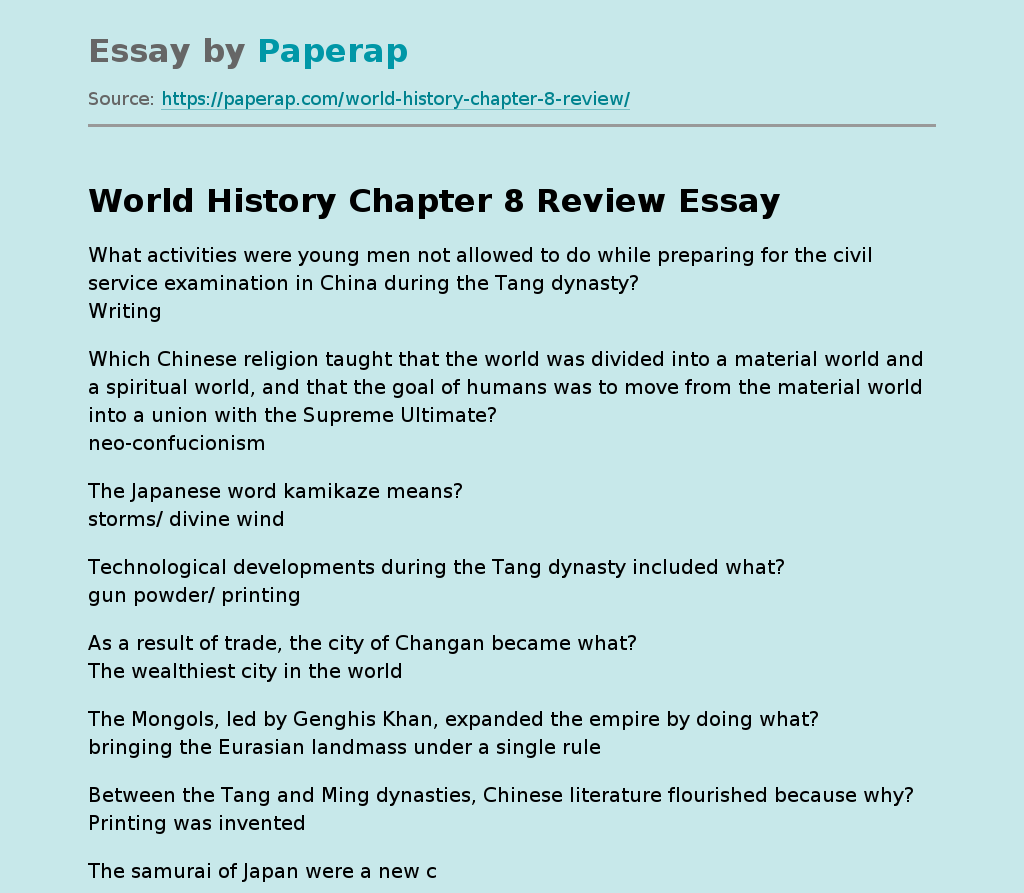World History Chapter 8 Review
Review,
Pages 3 (673 words)
Views
33
What activities were young men not allowed to do while preparing for the civil service examination in China during the Tang dynasty?
Writing
Which Chinese religion taught that the world was divided into a material world and a spiritual world, and that the goal of humans was to move from the material world into a union with the Supreme Ultimate?
neo-confucionism
The Japanese word kamikaze means?
storms/ divine wind
Technological developments during the Tang dynasty included what?
gun powder/ printing
As a result of trade, the city of Changan became what?
The wealthiest city in the world
The Mongols, led by Genghis Khan, expanded the empire by doing what?
bringing the Eurasian landmass under a single rule
Between the Tang and Ming dynasties, Chinese literature flourished because why?
Printing was invented
The samurai of Japan were a new class of military servants whose purpose was to what?
Protect the security of their employers
Which two factors contributed to the failure of Kublai Khan’s invasion of Japan in 1281?
The Kamakura shogunate and massive typhoon that destroyed most of the invading fleet
Followers of Theravada see Buddhism as what?
A way of life
Who was the ruler of a Mongol State based in Samarqand
Timur Lenk
The trading societies of Southeast Asia included what?
Srivijaya
In the Tang and Song Eras, the old landed aristocracy was replaced by?
Scholar-gentry
Emperor Tang Xuanzang is remembered for what?
his devotion to a commoners daughter
In 1206 Temujin was elected Genghis Khan,after which he devoted himself to what?
conquest; eventually establishing the mongol empire
Which philosophy was at the heart of the Chinese state government from the Song Dynasty to the end of the dynastic system in the twentieth century?
Confucianism
The samurai lived by a strict code known as?
Bushido
Korean society was strongly influenced by?
the Chinese model of society
Followers of Mahayan saw Buddhism as?
religion not a philosophy
Most Muslim rulers in India were tolerant of Hindus because why?
There were too many Hindus to convert them all
What are the two major pars of Southeast Asia
The mainland down the Southern tip and the archipelago
What caused Buddhism and Daoism to become more attractive to the people of China?
feelings of insecurities
Which Japanese religion, still practiced today, includes a belief that people’s ancestors are present in the air around them?
Shinto
The most popular sect of Buddhism in early Japan was?
Zen
Who first introduced Buddhism in Japan in the sixth century A.D?
Buddhist monks from China
Who were heads of noble families who controlled vast landed estates in Japan?
Daimyo
The mongol capital of Khanbalik later became known by the Chinese name?
Beljing
After the death of Genghis Khan, the Mongol empire was divided among his sons into separate territories known as?
Khanates
Which two rivers were linked by China’s Grand Canal?
Huang He and Chang Jiang
Ghazna
ruler
Bushido
this strongly influenced Korean society
confucianism
a system of philosophical teaching
temujin
unified the mongols
daimyo
head of noble families
samurai
warriors; “those who serve” fought on horseback
bejing
the city of the Khan
theravada
the teachings of the elders; believed Buddhism was a way of life.
shogun
a military general
gunpowder
technological finding in the tang dynasty
mahayana
a school that believed Therevada teachings were too strict
scholar-gentry
replaced the old landed aristocracy as the political and economic elite of Chinese Society
Sui
did not last long but it unified China once again
Jayavarman
united the Khmer people and established a capital at Angkor Thom
Timur Lenk
the ruler of a Mongol State based in Samarqana
Tang
a new dynasty that lased nearly three hundred years
rajputs
Hindu warriors
Li Bo
a free spirit whose writing centered on nature
yi song-gye
a military commander; seized power and founded the yi dynasty
Hangzhou
south of the chang jiang river delta
Wu Zhao
known as Empress Wu; one of the few woman that had power
Dufu
a serious Confucian
Dandin
Author who wrote sanskrit prose and authored the adventures of 10 princes
World History Chapter 8 Review. (2019, Feb 12). Retrieved from https://paperap.com/world-history-chapter-8-review/
